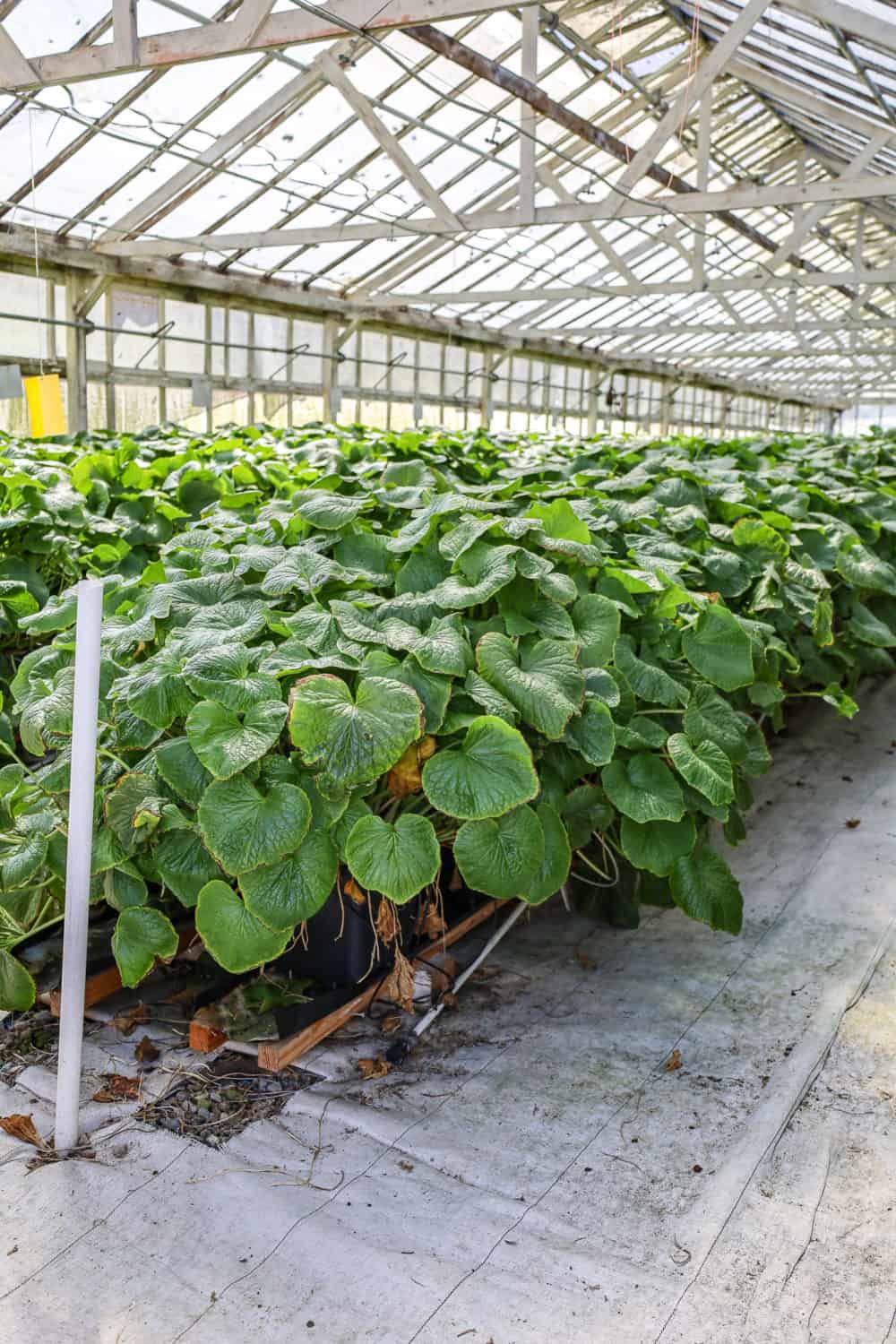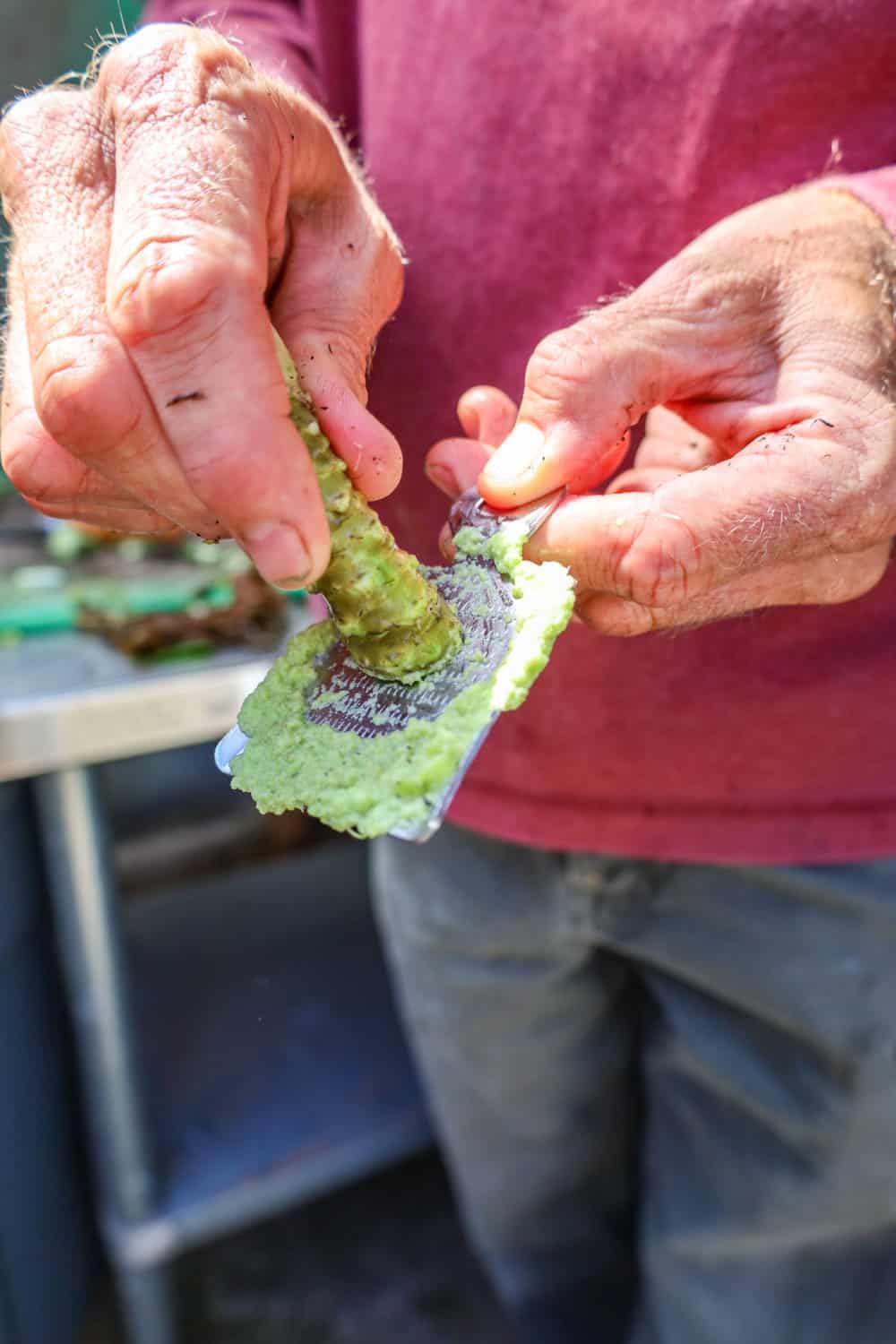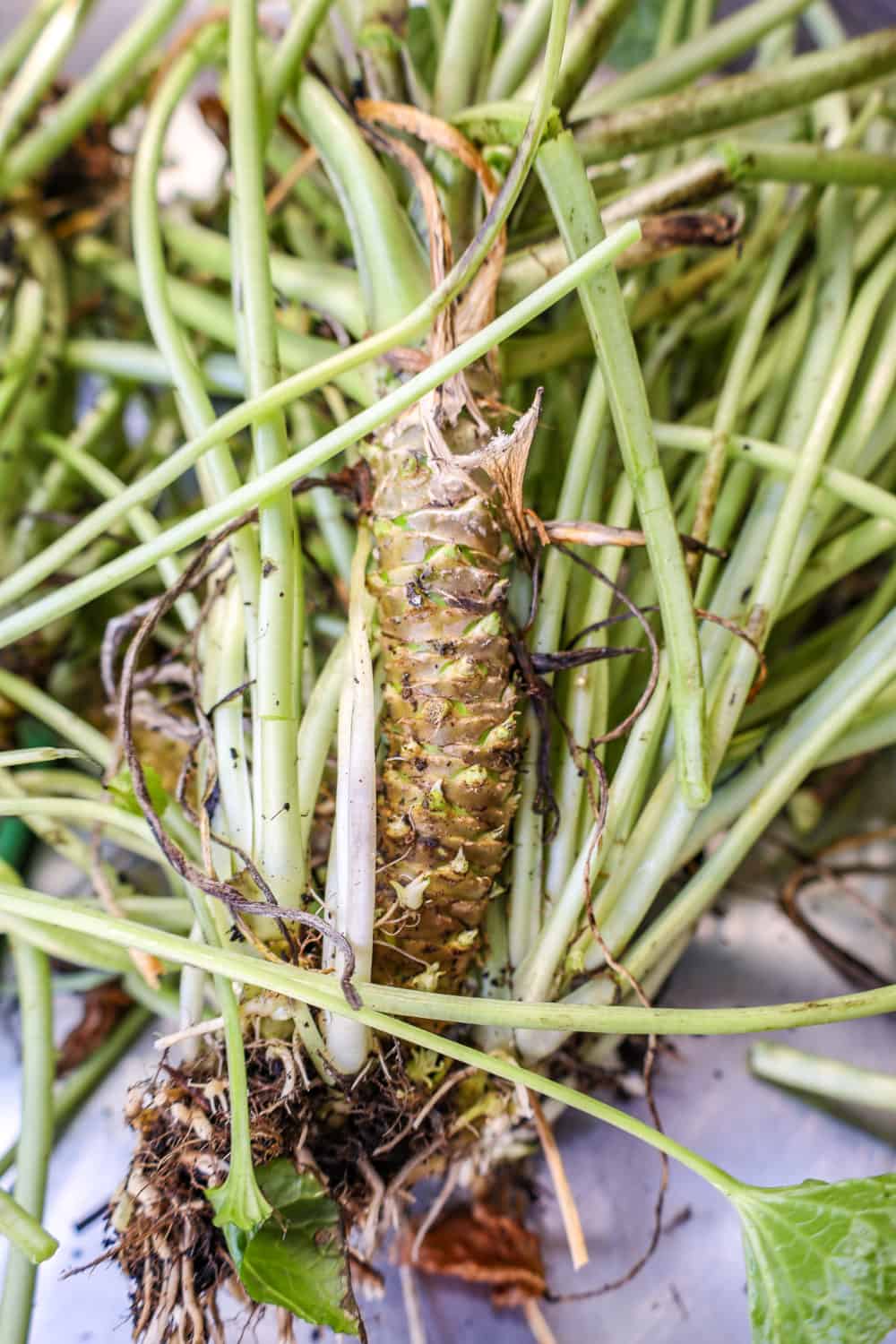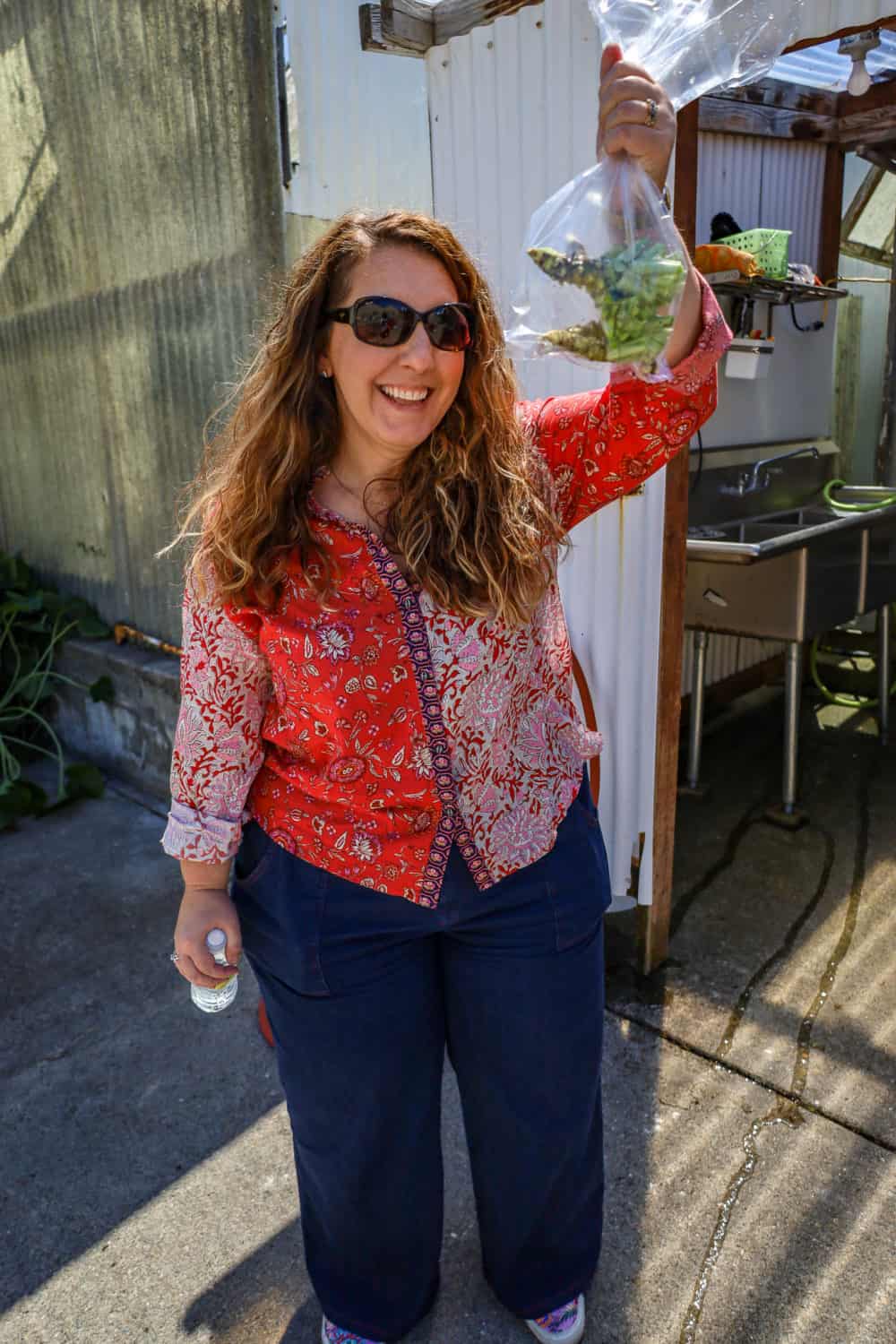Learn How Wasabi Is Grown in California
Bet you’ve never had real wasabi before!
Lots of Americans love sushi. And sushi isn’t the same without that dollop of neon green wasabi served alongside. We hate to break it to you, but your favorite sushi bar probably isn’t serving the real stuff. We recently had the opportunity to meet Jeff Roller who is co-owner of Half Moon Bay Wasabi Farm. He showed us how wasabi is grown in California, and also told us how to tell if you’re being served the real deal.
According to the Washington Post, about 99% of wasabi served in the U.S. is fake. That dab of sinus-clearing paste that accompanies your California roll is most likely horseradish or mustard powder mixed with green food coloring. Part of the reason why most sushi joints in the U.S. don’t serve genuine wasabi is that it’s hard to find. There are only a handful of wasabi growers in the United States. Also, growers in Japan have seen their crops reduced by 55% in the last decade due to deforestation, climate change, disease, and pests.

So what is real wasabi anyway?
Wasabi is a rhizome of the Wasabia japonica plant. Rhizomes are underground stems that send out roots and shoots from bumpy nodes. Other plants that have rhizomes include ginger, turmeric, and galangal which are also edible, along with orchids, ferns, and lilies.
What does wasabi taste like?
Unlike chilies which get their heat from capsaicin, wasabi’s signature pungent heat comes from allyl isothiocyanate. That sinus clearing sensation happens because our receptors for that particular chemical in wasabi are in our nostrils.
Through trial and error, Half Moon Bay Wasabi Farm settled on two varieties – spicy and one that is a little less so. “People think real wasabi should be hotter than the fake stuff, but chefs prefer the more subtle variety. We have one that’s a little sweeter and the chefs really like that one,” Roller said.
Roller told us that wasabi’s heat comes from grating it and the resulting exposure to oxygen. “If you just take a bite of wasabi it has no heat, it’s just kind of a bitter flavor. You gotta grind it up, and you wanna wait five minutes for the flavor to build. Then ideally you want to consume it within a half hour because the heat dissipates,” he shared.
Real wasabi has a looser texture than fake wasabi. The fake stuff is totally smooth due to being pureed. Fresh wasabi can be a bit granular because it’s freshly grated. Sushi chefs grate fresh wasabi to order, and often in front of the guest to prove they are using the real deal.

How wasabi is grown in California
Roller and his partner Tim Hall, both electricians by trade, were looking for a way to earn extra income during the economic downturn in 2010. Over a sushi dinner, and lamenting the fact that most wasabi isn’t real, they tossed around the idea of starting a wasabi farm and trying to learn how wasabi is grown.
They studied how and where farmers in Japan grow wasabi and realized that the cool, moist climate of the Bay Area was similar to the climate in the Japanese growing regions. But starting a wasabi farm was risky if there was no demand for it in the United States. “We went back to our sushi chef friend to see if he would buy it if we started growing it. He laughed and told us that it was too hard to grow. But if we could grow it, he promised he would buy it,” mused Roller.
The electrical business was slow, so they used their downtime to look for the right place to start their farm. It took them a long time to find their location, but they settled on a small greenhouse that formerly housed a flower farm.
They learned through trial and error – a lot of error
Wasabi is a notoriously finicky crop. It’s very slow growing and can take up to three years to be ready for harvest. If something goes wrong during that time, years of work and an entire crop can be lost. Roller is all too familiar with that kind of heartbreak. When they were just starting out, there wasn’t a lot of information on how to successfully grow wasabi, especially outside of Japan.
“When we first got started, we just tinkered around and tried growing our first crop. At first, it would seem like everything was going well, then after several months it would collapse and we had to throw everything out. It was an utter failure and it was heartbreaking. We learned that wasabi needs very specific types of water, temperatures, and irrigation frequency. Soil type is also critical,” he remarked.
“Back then we tried growing it in gravel and all sorts of crazy stuff, and now we are always trying different mixes to see what works best. It’s hard because this plant takes so long to grow. All the little variables we have to learn by trial and error. There is no playbook. And it’s hard to mark changes and really see what exactly has worked,” Roller continued.
“We’ve been through a lot of things, diseases that we had to figure out. We learned from berry growers down in Watsonville and we’ve run into very smart people along the way that have given us ideas to try. I hate to jinx it but it’s kind of humming along right now,” he said with a chuckle.
Today Roller and Hall have a couple of employees besides themselves that manage the greenhouses and harvest the crops. “We harvest every Monday and haven’t missed a Monday in 4 years,” Roller boasted. “The chefs depend on us and our goal is to not run out.”
They now have three greenhouses on the property with 6000 wasabi plants in various stages of development – from tiny sprouting plants to large leafy plants that are ready to harvest. “These plants are about 18 or 19 months. We generally harvest from 18 months to two years,” Roller said while gesturing to the waist-high plants in the greenhouse.
During the pandemic, they had to throw away an entire greenhouse worth of wasabi because demand dropped so much. If there’s any silver lining it’s that they learned to ship their product direct to consumers and also to places like Texas and Florida that ended their shutdowns long before California did. Their sushi-chef friend, the one who was supportive from the beginning, also helped them out. He kept his restaurant, Rintaro, open for takeout during most of the shutdown. He encouraged his customers to buy fresh wasabi, which he began selling at the restaurant.
Someday soon Roller and Hall hope to be able to quit their jobs as electricians and focus on their wasabi farm full time. They are looking for greenhouses to expand into, but like much of the Bay Area, the real estate market is tight. Their top priority is staying in California. “Our families are here, our customers are here – we’re not going anywhere,” promised Roller.

How to buy and store fresh wasabi
Though nearly all of their business remains direct sales to chefs, and primarily to chefs in the Bay Area, since the pandemic they have also been selling direct to consumers. You can order their products online, including wasabi plant starts, fresh rhizomes, leaves and stems (which are also wonderfully flavorful), and t-shirts.
Roller recommends storing the wasabi rhizomes in a jar of water in the fridge, changing the water every 2-3 days. That way it’ll last up to a month. You can also keep it in a plastic bag, but it will oxidize and turn black (purely a cosmetic issue). Just shave it down to remove the oxidation.

How to score fresh Half Moon Bay Wasabi
How wasabi is grown: article and images by Alison Needham

